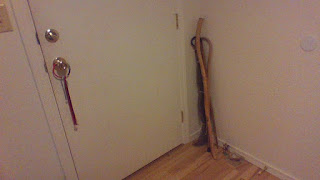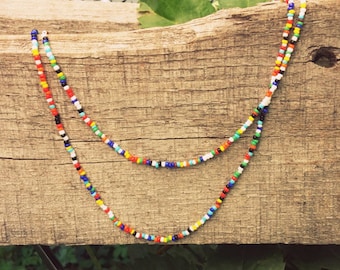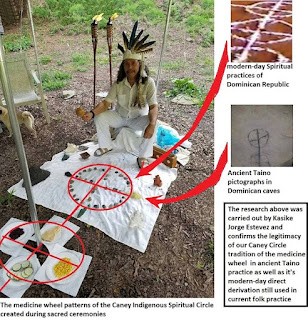In honor of his day I decided to tell the story of Vodou creation.
The first version was taken from " By The Kingdom of This World ",by Alejo Carpentier:
Long ago, the serpent spirit Danbala created the world. He used his 7,000 coils to form the stars and the planets in the heavens and to shape the hills and valleys on earth. He used lightning bolts to forge metals and make the sacred rocks and stones. When he shed his skin he created all the waters on the earth. And when the sun showed through mist settling on the plants and trees a rainbow was born. Her name was Ayida Wedo.”(the rainbow snake)
I would like to share a similar oral mystery story passed down from a Houngan to our family:
Houngan Steve M has become Ghede to our local group, as well as in other temples, at least one other American Haitian temple I am aware of where his asson sits. I never got to meet him but his influence and his teachings continues to this day.
Dhamballah lay surrounding around the earth holding it together. He began to stir turn and twist the movements made mountains and valleys as he uncoiled it became shaped. He saw something in the sky which may have been the face of Bondye or a great star. He went into the sky and waters dripped off the body, he opened his mouth and it began to pour upon the earth. When he did that, the sun reflected off the waters and he saw Aida Wedo the rainbow serpent. They fell in love and intertwined. Aida Wedo coming up to meet him, and him coming down to earth began all creation.
.........
He carried the Lwa from the sky and she up from earth carries the dead as they rise on the world tree or temple pillar. In some stories he carried the ancestors on his back as the waves when the slaves came from Africa to Haiti instead of the story with the ship Immamou and Captain Agwe.
In the first story 7 is the celestial number of spectrum and planets of the universe. It mirrors the biblical story of creation in 7 days. Blacksmith spirits in several cultures are associated with creation, metals and magic. Water and Fire creates alchemical steam or air and the rainbow.
Some people see Aida Wedo and Dhamballah as the same entity in one, such as the hermetic beings or the mind which contains both polarities. They are viewed slightly different in Africa than Haiti. The 2 snakes also is similar to the healing rod of the Greek god Aesculapius and the mercurial wand. Seen in the medical symbol. Mercury being of air, the mind, magic, communication and sexuality.
Coils also bring to mind the spiral energy of DNA, and sacred geometry of creation. The snake movement of constricting and loosening is like formation of the universe and star systems. The movement of undulating, back and forth is like energy wavelength. The coils or spirals are like sacred geometry the Fibonacci sequence and divine ratio.
Some use Martha the Dominator for Aida Wedo or Mami Wata, a pantheon of snake like spirits or for La Sirene. But we use that for a river snake Lwa Lubana. We use the saint image Mary of (divine) grace for Aida Wedo the rainbow snake, Some use the Lady of Immaculate Conception image.
Sometimes she is pictured standing on a new moon or rainbow instead.
She is credited with holding up the world. The words, ma, material, matter, mother being interconnected. Snakes are images of ancient ancestors.
She is credited with holding up the world. The words, ma, material, matter, mother being interconnected. Snakes are images of ancient ancestors.
The rainbow snake also is a theme for creation with Australian Aboriginals, but also in central America the Quetzalcoatl "twins" solar multicolored feathered snake so these ideas are pre-christian. From Greece the image of the snake and egg oomphalos represented the navel or center of the world and communication with the gods, the pythoness divinitory oracle of Delphi. In Ireland serpent mounds were burial sites of the fae and ancestors.
It is not hard to see the procreation knowledge of sperm and ova, potentiality and seed, 1 and 0 binary creation.
It is not hard to see the procreation knowledge of sperm and ova, potentiality and seed, 1 and 0 binary creation.
Snakes remain as the bridge between and identified both with earth and the celestial or spiritual. The spanish word culebra and culev or culeb mean both "snake" and "covering", the snake skin that covers the material world.
Ayahuascha a visionary plant, sees the rope vine as a snake, related to DNA and illusions or maya, spiritual axis ladder, light to be able to see the world in a "shamanic" way, beyond the veil or covering; in which they are taught many things. An Ayahuasquero and Tabaquero, says that snakes are the mother of the plants which explains why they see snakes when using the plant teacher, and that the vine is the mother of tobacco. This also explains tobacco's properties being able to draw and communicate with spirits.
RE: The cosmic serpent: DNA and the origins of knowledge by Jeremy Narby. The plant mixture contains DMT which has been dubbed "the spirit molecule", present at birth, death and during dreams, hypnogogic and other "hallucinations" written about by R Strassman.
In the bible it brings to mind Acts 9:18 Immediately, something like scales fell from Saul's eyes, and he could see again. He got up and was baptized...He had the scales or veil removed and he regained his sight and ability to see the truth and was initiated into the mystery.



























